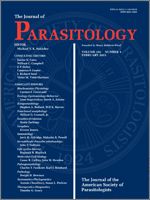The northern fowl mite, Ornithonyssus sylviarum (Canestri & Fanzago), is an ectoparasite of more than 70 species of North American wild birds, but it has a particularly significant impact on chickens, where it is a permanent resident of vent feathers. Improved control practices depend on a better understanding of host–mite relationships. ISA Brown hens were inoculated experimentally with northern fowl mite adults, and northern fowl mite populations developed naturally. Using a fast-response microprobe, temperatures of individual vent feathers (n = 15) were recorded at 5-mm increments along the length of the feather shaft. Immediately after temperatures were recorded, the individual feathers were quickly clipped at the skin surface and then flash-frozen between 2 small blocks of dry ice, freezing all northern fowl mite stages in situ. The feathers then were cut into 5-mm sections for careful mite enumeration by life stage. There were no overall differences among life stages in the distributions on the feather. Mite positions on feathers (distance from skin) varied distinctly with feather zone temperatures, as well as with ambient and average temperatures over the prior 24 hr. Ambient temperature at time of sampling affected the positions of the 2 mobile categories, adults and larvae/nymphs, but showed no statistical relationship with egg distribution. In contrast, ambient 24-hr temperature influenced the positions of all life stages. On-host feather temperatures reflected ambient temperatures. Feathers collected on hot days (ambient temperatures of 23–33 C) provided a narrow and quite warm range of temperature conditions for mites (often >30–36 C). Temperatures on cool days (ambient temperatures of <23 C) provided much wider on-host temperature ranges for mites to occupy (13–35 C). Mites were farther from the skin on warmer days. When mites had a broad range of temperatures, the feather temperature zone occupied by all life stages averaged 28–29 C. Mites move to occupy favorable temperature conditions on-host. When further out on feathers in warm weather, and under thermal stress, northern fowl mites either move off host or are dislodged. They then become a human pest, are noticed by farmers, and are more likely to disperse.
BioOne.org will be down briefly for maintenance on 17 December 2024 between 18:00-22:00 Pacific Time US. We apologize for any inconvenience.
How to translate text using browser tools
1 February 2015
Temperature Governs On-Host Distribution of the Northern Fowl Mite, Ornithonyssus sylviarum (Acari: Macronyssidae)
Deborah G. De La Riva,
Diane Soto,
Bradley A. Mullens
ACCESS THE FULL ARTICLE

Journal of Parasitology
Vol. 101 • No. 1
February 2015
Vol. 101 • No. 1
February 2015




